Guest Post: What makes a Great Commedia Mask? by Stanley Allan Sherman
[I’ve asked a few great mask makers to submit a guest post entitled: What Makes A Great Commedia Mask? Their responses will appear here over the next few days. The images sprinkled throughout this page are from the author’s website, copyright by the author (as is the text), and used by permission. For permission to reprint this article or the images, please contact the author on the listed website.
This post is by Stanley Allan Sherman of Mask Arts Company & Roving Classical Commedia University* (* totally unaccredited). Stanley is a graduate of Ecole Jacque Lecoq, and performed and toured his solo show from the 1970’s into the 1990’s. Since then he has done lots of television work, was Off Broadway for 3 1/2 years, and currently lives in NY where he makes masks, directs, and teaches a number of classes in mime, mask-making, classical commedia dell’arte, and other related subjects.] For more information, visit http://www.maskarts.com or http://www.commediau.com]
In Bali the mask makers make two kinds of masks, ones for the tourist, the others for their festivals. The difference is they put a soul into the masks they use for their festivals. The masks they sell to the tourists they do not bother putting a soul in.
That is from an article in the Drama Review back in the late 70’s or 80’s written by a fellow whose name I am sorry to say I forget. [Editors note: I am guessing it is either Ron Jenkins or John Emigh]
“You want a mask with a soul in it,” Carlo Mazzone-Clementi told me, “For live theater you need a live mask made out of a live material; leather, wood or paper, not plastic. Hair really makes a mask come alive.”
As a mask maker and maker of custom fitted leather clown noses, a performer knows when a mask is meant for him or her, it is the same with a clown nose. With the right mask your Commedia dell’Arte character and personality easily comes out and alive taking you to areas where you would not normally go. A great mask can free you to go beyond yourself. Today there are many kinds of Commedia dell’Arte masks to choose from.
A Little History
 Since the 1970’ s many maskmakers have been copying the style and construction of Amleto Sartori who died in 1962. He is the one who made masks for Jacque Lecoq, who was one of my teachers.
Since the 1970’ s many maskmakers have been copying the style and construction of Amleto Sartori who died in 1962. He is the one who made masks for Jacque Lecoq, who was one of my teachers.
What were the Commedia dell Arte character masks in the 1500’s and 1600’s? What did they look like? It is hard to know. We do have some ideas from the surviving historical prints. But there are few along with other records. Masks in Europe during the time of the Commedia dell’Arte were made out of leather or pressed waxed paper. I have seen no historical evidence that speaks about the color of the masks. It is believed that the masks were dark or black, but that could be because as some leather ages it gets dark.
There is Southern Commedia dell’Arte and Northern Commedia dell’Arte – very different although there are similarities. I have not seen Pulcinella in any Northern scenarii, nor Arlechino in any southern scenarii. Pantalone I have only seen in one or two Southern scenarii. Carlo also said, “Ignore the Southern Commedia dell’Arte — they mix everything up.”
Of the many Commedia dell Arte companies of the day, we know the most about the greats like Gelosi company. Many people today disagree about facts. Carlo Mazzone-Clementi made a great statement in 1974, which is found in Thomas F. Heck’s book, Commedia dell Arte: A Guide to the Primary and Secondary Literature, “Anyone can open a drawer marked Commedia dell’Arte, but, having opened it, how does one know what to choose from it?”
The drawer of Commedia is very big and the key is to know what to take out, what mask to choose. You have to use your gut instinct.
The Art Form
In choosing a good Commedia dell’Arte mask we must get into the art form; what is Commedia dell’Arte and what is it not? It is not cartoons. It is not melodrama. It is not slapstick. When choosing a mask watch out for these strong features. Why, because otherwise you can get stuck in very narrow interpretation.
It is an improvisational form of theater developed in the mid 1500 s in what we now know as Italy. (Some people now are trying to say it was not that improvised.) It uses scenarii and the Commedia dell’Arte players had to know mime, prop manipulation, dance, music, stage combat, acrobatics, how to work with one another, give and listen on stage, and sometimes even work with animals. Lovers had to know poetry, Latin, the latest fashion, how royalty conducted themselves and the audience had to believe everything they did. When wearing a mask, if you are totally in the character, the audience only sees your character. The mask is alive through ones movements and stillness. If the performer is not being real the audience will see only an actor with a mask covering his or her face.
Each character had special talents they needed to know. Dottore players were known for carrying around a well-guarded book of etymology jokes which they themselves developed and added to. For Capitano it was very helpful to know history of war and battles. And most characters had a working knowledge of classical mythology. Knowing whom your character is helps in choosing a mask. If you are buying a set of masks look at who is going to wear them; what type of Arlecchino you want? Pantalone? Brighella? The Commedia dell’Arte characters changed through time and they changed because of who was playing the role.
One thing I have seen a lot of which does not seem to fit are all the penis noses on Commedia dell Arte characters masks today. These penis nose masks seem very popular among some teacher and performers. For me it seems more of the spin of how some people would like to see Commedia dell’Arte today, little off and more cartooned than how I believe it was. It is fine if that is what you want or need to play in today. But a mask must have dimensions — if all you see is a penis mask that is all you may get. These characters were multidimensional. People relate to them.
When I started sculpting Commedia dell’Arte masks I worked not from photos or prints but from emotions, history, voice and movement. An excellent mask maker can put several emotions into their mask characters, and those emotions can conflict. Often you will know when a mask is meant for you.
In our Roving Classical Commedia University* (*totally unaccredited) (now in its tenth year!) we have seen what works with mask. One big advantage for our students is that I am a mask maker. Hence they have several masks of each character to try. Students try on one Pantalone, improvising a piece of a sentence of a scenario from the late 1500’s to early 1600’s. That mask may not work with him or her, but a different Pantalone mask will fit their Commedia dell Arte spirit perfectly.
A Word About Leather versus Neoprene Latex
If you are allergic to neoprene latex check with your doctor first before you wear or handle it. (Having a friend that runs the toxicology department at a major hospital in NYC, he lectured me for 20 minutes on why I need a warning on my website.)
Neoprene latex is a cheap alternative to leather. It will not last as long and is not as durable or comfortable but one can get many years out of a good neoprene latex mask. With tight budgets it is a good alternative and many schools, colleges, universities and professional companies use neoprene latex over leather because of the price difference alone. But as Carlo Mazzone-Clementi would say, “It is not a live material.” Some leather masks I have used for over 20 years.
One performer, musician, dancer and singer who performs a lot with his mask, has a Pantalone I made for him over 15 years ago and he just brought it in for a tune-up. It looks better now than it did when I first sold it to him. You can rejuvenate a leather mask. Every mask is a little different even if it comes from the same mask mold. When I make a mask for a performer  I have him or her in mind while I am creating it and often have their photo up as well.
It is important to put the right energy into the mask so it will fit with the performer’s energy, so they will be able to make it live a full life on stage.
Making a mask is not just technique; it is a lot of soul. Look for a mask with a soul in it and listen to your gut instinct.


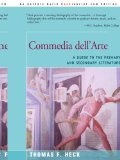
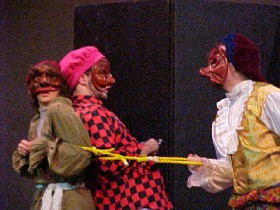
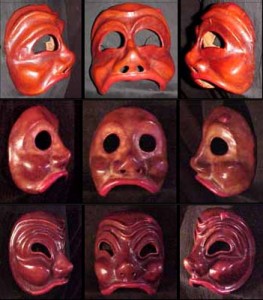
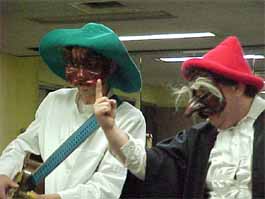
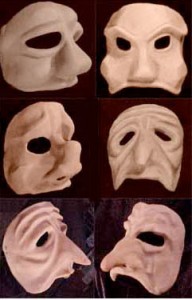
Can you post an example of the “penis nosed” character verses the traditional?
really great article.
Pingback: RCCU’s 10nth Anniversary Workshops June 12-July 1 (NY)
I did a class on this in 2011. When I got to the stage of rubbing the sweat of my brow into the Brighella mask I was making, it began to take on a glow like natural, living skin. It was quite bizzare. Certainly felt like I was putting a bit of my soul into it. Almost a shame to have to paint it.Â
Does anyone know where I can buy the wooden Commedia mask molds that the masks are shaped over? I’m not sure I can carve my own.Â